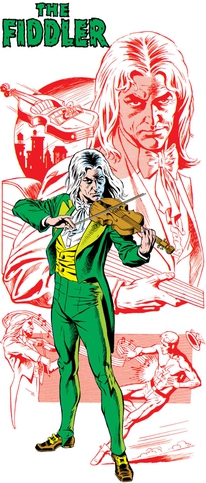Pre-Crisis
The Fiddler started out as a thief who was arrested in India and sent to jail. While in prison, he met a fakir, charming a snake in his cell, who taught him the "mystic art" of Indian music. For the next five years, he learned the fakir's secret and made a crude violin made of material he could scrounge in the prison. He developed the ability to use his violin to play sounds that could either hypnotize others, shatter objects, or create barriers. [2] After the fakir declared his student had surpassed him, he used the instrument to hypnotize the guards to open their cells and he and the fakir escaped. He then murdered the fakir and the merchant who had him arrested in the first place. [3]
Returning to the United States, the Fiddler battles the Flash (Jay Garrick). Flash foils his plan, which involved replacing Maestro Bowin, his twin brother and a violin virtuoso. The physical similarity between the brothers (who had been separated at birth) leads to Bowin being suspected of the Fiddler's crimes. The Fiddler captures his brother and Flash, but they escapes and the Fiddler apparently committed suicide by diving into a river.
The Fiddler survives his plunge into the river and returns to battle the Flash again a few months later. He refines his appearance, shaving his hair and donning a powdered white wig. After the Flash thwarts a petty theft and arrests most of his gang, the Fiddler schemes to make him retire by making him believe that he is not needed. Jay's wife Joan, regretting her earlier arguments with him, operates in his place, using mirrors to create the illusion that she is moving at superhuman speeds. Nonetheless, the Fiddler resolves to dispose of Joan and ties her to a nearby train track. Jay quickly rescues her and attacks the Fiddler, who falls to his presumed death. [4]
Since then, he continued to plague the Flash again and again. He was a member of the second Injustice Society, who captured the JSA and briefly put them under their control before Harlequin and Black Canary restored their memories.
Later, the Fiddler was part of a trio of criminals that caused the original Flash to come out of retirement. The Fiddler, along with the Shade and the Thinker, were stopped by the first of many team-ups of Earth-One and Earth-Two heroes in "Flash of Two Worlds". [5] Barry Allen, the Earth-One Flash, visits Earth-Two accidentally and encounters Jay Garrick, who exists as a fictional character on Earth-One. Together, the two Flashes stop the villains. This issue led to many other team-ups between Earth-One and Earth-Two heroes and villains. The Fiddler, with the Wizard and Icicle formed the "Crime Champions" who, with the Crime Champions of Earth-One (Doctor Alchemy, Chronos, and Felix Faust), try to commit robberies after the Fiddler accidentally discovers a method of traveling between universes.
Post-Crisis
In post- Crisis continuity, the Fiddler is Isaac Bowin, a member of the Injustice Society and the son of British aristocrats. His early encounters with the Flash are kept in continuity. In John Ostrander's Hawkworld series, it is revealed that the fakir who taught Bowin his hypnotic skills was actually a demon.
In the series Villains United , the Fiddler joins the Secret Six. Disappointed by the Fiddler's performance against H.I.V.E. agents during their first mission, Mockingbird deems him "incompetent" and orders him killed. Deadshot carries out the execution; following Fiddler's death, he is replaced on the team by Catman. [6]
In Blackest Night , Fiddler is among many deceased villains who are reanimated as members of the Black Lantern Corps. [7] He features prominently as a Black Lantern during a short story-arc running through the one-shot revival issue of Suicide Squad , and the following two issues of Secret Six. [8]
